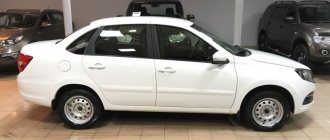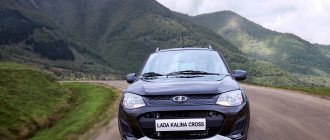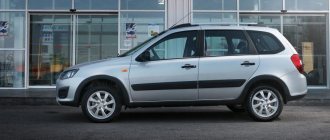The release of the new Russian car Lada Vesta is undoubtedly an important event. Why this car is really qualitatively different from previous Lada models is explained by Sergey Stillavin in the “Big Test Drive” of the Lada Vesta.
It is worth reminding readers that this series of video reviews, dedicated to the development of the Russian automobile industry and testing the qualities of foreign cars, has undoubted authority. The information provided to numerous viewers and fans in the “Big Test Drive” of the Lada Vesta has a high level of relevance due to its receipt directly from the manufacturers.
LADA Vesta SW Cross configurations and prices
Select a package to view the basic and additional equipment that is included in it.
- Vesta SW Cross
- Vesta
- Vesta Cross
- Vesta SW
- Vesta Sport
| Equipment | Body | Engine | Power | Box | Drive unit | Overclocking | Speed | Consumption | Price |
| Comfort | gasoline 1.6 l. | 106 hp | M.T. | Front | 12.6 sec. | 178 km/h. | 9.7 | 6.0 | 7.5 | 866 900 | |
| Comfort | gasoline 1.8 l. | 122 hp | M.T. | Front | 11.2 sec. | 180 km/h. | 10.7 | 6.4 | 7.9 | 891 900 | |
| BLACK | gasoline 1.6 l. | 106 hp | M.T. | Front | 12.6 sec. | 178 km/h. | 9.7 | 6.0 | 7.5 | 901 900 | |
| Luxe | gasoline 1.6 l. | 106 hp | M.T. | Front | 12.6 sec. | 178 km/h. | 9.7 | 6.0 | 7.5 | 919 900 | |
| Luxe | gasoline 1.8 l. | 122 hp | M.T. | Front | 11.2 sec. | 180 km/h. | 10.7 | 6.4 | 7.9 | 944 900 | |
| Comfort | gasoline 1.6 l. | 113 hp | CVT | Front | 12.2 sec. | 170 km/h. | 9.6 | 6.1 | 7.4 | 951 900 | |
| Luxe Multimedia | gasoline 1.6 l. | 106 hp | M.T. | Front | 12.6 sec. | 178 km/h. | 9.7 | 6.0 | 7.5 | 960 900 | |
| Luxe Multimedia | gasoline 1.8 l. | 122 hp | M.T. | Front | 11.2 sec. | 180 km/h. | 10.7 | 6.4 | 7.9 | 985 900 | |
| BLACK | gasoline 1.6 l. | 113 hp | CVT | Front | 12.2 sec. | 170 km/h. | 9.6 | 6.1 | 7.4 | 986 900 | |
| Luxe | gasoline 1.6 l. | 113 hp | CVT | Front | 12.2 sec. | 170 km/h. | 9.6 | 6.1 | 7.4 | 1 004 900 | |
| Luxe Prestige | gasoline 1.8 l. | 122 hp | M.T. | Front | 11.2 sec. | 180 km/h. | 10.7 | 6.4 | 7.9 | 1 007 900 | |
| Luxe Multimedia | gasoline 1.6 l. | 113 hp | CVT | Front | 12.2 sec. | 170 km/h. | 9.6 | 6.1 | 7.4 | 1 045 900 | |
| Luxe Prestige | gasoline 1.6 l. | 113 hp | CVT | Front | 12.2 sec. | 170 km/h. | 9.6 | 6.1 | 7.4 | 1 067 900 |
The table contains the following data: name of the configuration, body, its engine (fuel, volume, power). Gearbox (MT - mechanical, AT - automatic, AMT - robotic, CVT - variator). Acceleration from 0 to 100 km/h. Maximum vehicle speed. Fuel consumption per 100 km in liters (in the city | on the highway | in the combined cycle). Manufacturer's recommended price for a new car (may not be current, check with your authorized dealer).
AutoVesti (Pavel Bludenov)
pros
- The suspension works great, the car is truly designed for Russian roads. Absorbs bumps well (better than Renault Kaptur).
- Excellent handling, even on bad roads.
Minuses
- Acceleration to 100 km/h is not impressive.
- The new instrument panel is blind, nothing is visible on it.
- AMT is not designed to be used.
- Multimedia system (the sun glares a lot and slows down).
- Below and above the engine behaves sadly.
- In 5th gear up a small hill the car does not accelerate at all.
Overall, the Lada Vestra SW turned out quite well. SW Cross seemed worse than a regular station wagon.
Big test drive Lada Vesta SV Cross
Lada Vesta Cross (lada vesta cross)
Back in March 2016, the hosts of a YouTube channel called Big Test Drive showed us a domestic novelty - the conceptual model of the Lada Vesta Cross.
A year and a half later, a video of the Lada Vesta Cross Big Test Drive appeared on their channel, where the presenters showed us the production version of the car.
The presenters of the program, Sergey Stillavin and Rustam Vakhidov, took a new product from the domestic automobile industry for testing - LADA Vesta Cross SW and tested it over several hundred kilometers. In their video, they are ready to tell us about their emotions, impressions and everything that they noticed and were surprised by in the new LADA VESTA SW CROSS. Expect information in the release about how the car drives, how it handles on the road and how it steers. The video lasts just over 20 minutes. Go!
Gear cycle
The “Big Test Drive” series of Lada Vesta programs began in 2015. To be more precise, the start of filming dates back to the end of January - the model attracted the attention of the program hosts more than six months before the official release. This topic interested both the presenters and the audience so much that it was decided to regularly broadcast information about the new AvtoVAZ model - the Lada Vesta literally gave birth to a whole season of reviews. The video “Big Test Drive” of the Lada Vesta, which is noteworthy, already a week after it appeared on the Internet, received more than ten million views. This can be considered an indicator of the high demand for information about the new Lada model as a whole.
Up in low gear
Review of the special edition Lada vesta cross [black]
I was tired of organizing a free presentation for Sochi taxi drivers, who, even forgetting about meeting the next arriving flight, came running to look at the car. I answer the last question: “From 639,900 rubles!”, I mean, of course, about the minimum price of the Lada Vesta SW, and I decisively get behind the wheel. Must go.
Leaving the city, I had already come to the conclusion that the Vesta station wagon drove exactly the same as a sedan, but then the road went uphill and I soon changed my mind. On mountain serpentine roads, when the car constantly has to be shifted from side to side, the stiffness of the suspension is a definite benefit. But here, it seems, it is even a little softer than that of the sedan. No, not so much that there is a feeling of excessive rolliness, but still softer. Apparently, the designers tried to make the car even more comfortable. On the one hand, it worked - even on very noticeable road irregularities it does not shake out the soul. On the other hand, the stability of the car on a long high-speed arc leaves much to be desired. Here it is not possible to set the steering wheel to a certain angle at the entrance to the turn and level it only at the exit. From time to time you have to steer a little. And, an interesting detail, even in a tense turn, Vesta does not at all strive to straighten the trajectory; rather, on the contrary, on uneven surfaces it tends to dive even steeper into the turn. Does this interfere with the driver? More likely no than yes. But this behavior makes the management process more interesting, adding some “zest” to it - and we have a girl with character!
Something else upset me. The test featured cars only with the top-end 122-horsepower 1.8-liter engine. Just in case, I’ll say that the choice of power units here is the same as on the sedan. The younger engine is 1.6 (106 hp), the older one is 1.8. Box – AMT or “mechanics”. But so far we have only been shown cars with a manual transmission. So, when driving around the city or on the highway, the tandem of a 122-horsepower engine with a manual transmission did not cause any complaints. But on a mountain road with long climbs and sharp turns, into which it would be logical to enter under the throttle and exit “under traction,” the car noticeably lacks this very traction. You have to constantly change gears, and the transition from the third stage to the second is often not enough and you even have to use the first. The engine, of course, roars in this mode, and fuel consumption eventually goes off scale beyond the 13 liter mark. per 100 km.
I will not rush to conclusions, but will simply assume that the problem lies in the unsuccessful selection of transmission gear ratios. Some of my colleagues suggested that, unlike the sedan, they used a different, “longer” main pair. I found neither direct confirmation nor refutation of this hypothesis in the technical documentation. In any case, if the sedan used a main gear with a gear ratio of 3.9, then it would be logical to put a “shorter” gear on the station wagon, for example, 4.1. Many well-known automakers, by the way, did this, based on the fact that the station wagon itself is slightly heavier than the sedan, and it can be loaded much more seriously. Yes, at the same time the maximum speed will drop slightly, fuel consumption may increase slightly, but there will be noticeably more traction. Acceleration to “hundreds” will also improve.
Generation II Test Drives 3 Generation I Test Drives 1
Nissan Almera Classic (sedan)
Generation N17 Test Drives 2
By the way, if you check the technical characteristics, the Vesta sedan accelerates to 100 km/h in 10.2 seconds, and a station wagon with the same engine in 10.9. Indirectly, this fact testifies in favor of the hypothesis I put forward about different main pairs or gear ratios in the transmission. I don’t think the acceleration dynamics could have been so noticeably affected by the difference in weight. And with the same level of equipment, the station wagon is about 20-30 kg heavier than the sedan. That's not a lot.
Gearbox: Renault brand, made in Russia
The Lada Vesta is equipped with a French 5-speed manual transmission JH3-510. The transmission housing is cast at VAZ's own metallurgy. Actually, all assembly is carried out in Tolyatti.
The choice in favor of a foreign gearbox was made due to the fact that in the native VAZ engineers were unable to overcome extraneous noise, in particular the hum of gears. It is known that the French gearbox costs AvtoVAZ 20% more than the domestic one.
Let us recall that the AMT “robot” was created on the basis of a domestic gearbox, in which the problem of noise (in particular, a muffled howl in second gear) is still relevant. We have no complaints about the performance characteristics of a manual transmission.
Re: On what platform is Lada Vesta produced?
Contrary to popular belief, the Vesta sedan is based on its own architecture, although borrowed from Renault cars. The base platform is called LADA B, but this does not mean that it is intended for B-class cars. The Vesta model itself is closer to the C-class.
Andrey755 Messages: 367 Registered: 09 Nov 2022, 03:10
Re: On what platform is Lada Vesta produced?
Too much was borrowed from Renault, but more, of course, was our own. And this fact inspires respect for AvtoVAZ. It’s good when your developments are brought to life, and even in this form, and do not remain exclusively in design drawings on paper.
Nick80 Posts: 110 Registered: Mar 26, 2022, 02:44
Service cost
Tires for lada vesta sw cross: how to choose winter and summer tires
It's no secret that the maintenance of Russian cars is one of the cheapest on the market. This applies not only to the cost of purchasing spare parts and other components, but also to compulsory motor liability insurance, as well as the mandatory payment of road tax. The last two articles directly depend on the power of the car’s engines, which the Lada Vesta SW, of course, cannot boast of.
At the same time, it boasts a significantly cheaper maintenance cost, unlike its European or Korean competitors. That is why Lada Vesta SW is very popular in the Russian automobile market. Completing scheduled maintenance every 15,000 km will provide the owner with warranty support for 3 years or 100,000 km. For maintenance, the car owner will have to pay from 5,000 to 8,000 rubles. At the same time, compulsory motor liability insurance will cost 5,000 to 6,000 rubles. The annual payment of road tax will average from 2500 to 3500 rubles.
Autoreview
It is beautiful, but not cheap, handles well, but accelerates poorly, practical, but voracious.
Suspension
:
- The suspension of the Lada Vesta SW and Lada Vesta SW Cross is different. On the cross version it is more “asphalt”.
- The suspension is denser, reactions are faster and more accurate, with it Vesta Cross rolls less and sways less.
- But it emphasizes waves and irregularities more strongly.
Control
:
- The elevated Cross controls more accurately and tastes better.
- The cross costs 830 thousand, but drives like a million. Reactions are fast and accurate, rolls are almost not felt.
Clearance
:
Ground clearance is 203 mm - Crete never dreamed of this, and Kaptur is only one millimeter higher, but from experience there is more confidence in the Lada's passport clearance.
Noise insulation
:
- Unexpectedly good sound insulation (in a station wagon it is almost quieter than in a sedan).
- The roar of the engine is insipid, the turn signals click poorly, the horn snarls in the voice of a cold teenager.
Body:
- The rigidity of the station wagon body compared to the sedan dropped by only 100 Nm/deg and amounts to 17900-18900 Nm/deg. To compensate for the lack of a rigid rear shelf, the design has several additional elements that strengthen the body.
- We hung one wheel, all doors open and close without problems.
Fuel consumption
the Cross version in mountainous areas floated from 12 to 14 liters per 100 km.
Link #1 and link #2 for a test drive.
Handling and off-road performance
Despite its fairly budget price, the 2021 Lada Vesta SW has very decent handling. Thus, the car is quite responsive to any movement of the steering wheel, thanks to the correct settings of the mechanism and the presence of an electric power steering. The station wagon takes turns confidently, and its possible drifts from the trajectory are predictable. Therefore, the driver will be able to slow down to the appropriate speed in advance. The only drawback is that when the car exits a turn, the steering wheel must be turned manually; the developers were unable to achieve full return action for it.
As for the off-road qualities of the car, you can’t count on the station wagon to “rock” in off-road conditions, of course. But overcoming obstacles such as speed bumps or bumps and holes on the road is something that Vesta SV can handle with a bang.
Is galvanizing of the body necessary?
Zinc is known for its water resistance, which has made it an essential component of materials designed for long-term use in conditions of constant exposure to moisture. Due to the fact that the car body is made of metal, it is vulnerable to corrosion, which can adversely affect the appearance of the car, and in the future, reduce its strength and shorten its service life.
Body assembly. Photo source: https://club-vesta.ru/ustrojstvo/zashhita-kuzova-lada-vesta-i-iks-rej-otsinkovka-grunt-ispytaniya
A material coated with a layer of zinc later begins to experience the harmful effects of rust, because the anti-corrosion shell is the first to take the blow.
Specifications
According to the stated technical characteristics of the Lada Vesta SV 2020 model year, it can be equipped with three engine options. They all differ in parameters, which must be taken into account during purchase:
- Economical 1.6-liter engine and manual transmission. The maximum power of this power unit is 122 horsepower at 5900 rpm. Recommended fuel is A-92 gasoline. The maximum speed of this configuration reaches 182 km/h. Acceleration time from 0 to 100 km is 10.9 seconds. In the combined driving cycle, fuel consumption per 100 kilometers reaches 7.8 liters. Additionally, the modification is equipped with a 5MT transmission.
- Standard 1.8-liter engine and manual transmission. The maximum power of this power unit is 106 horsepower at 5800 rpm. Recommended fuel is A-92 gasoline. The maximum speed of this configuration reaches 178 km/h. Acceleration time from 0 to 100 km is 12.4 seconds. In the combined driving cycle, fuel consumption per 100 kilometers reaches 7.3 liters. Additionally, the modification is equipped with a 5-speed transmission.
- Classic 1.6-liter engine and automatic transmission. The maximum power of this power unit is 83 horsepower at 5500 rpm. Recommended fuel is A-92 gasoline. The maximum speed of the car in this configuration reaches 170 km/h. Acceleration time from 0 to 100 km is 12.2 seconds. In the combined driving cycle, fuel consumption per 100 kilometers reaches 7.4 liters. Additionally, the modification is equipped with an automatic transmission.
Gearbox leverAll internal combustion engines of different vehicle configurations provide smooth movement and confident acceleration. To achieve the proper level of comfort and exciting handling, the manufacturer has provided special chassis settings.
Description of video reviews
What are we talking about in the “Big Test Drive” of the Lada Vesta? Naturally, the leading programs tried to saturate each episode as much as possible with proven, reliable and interesting information for domestic car enthusiasts. It is worth saying that it was thanks to their first video from the cycle dedicated to Vesta that Russian drivers received a more or less accurate idea of the expected quality level of this model.
In the first episode, the presenters managed to visit the AvtoVAZ concern and not only talk with the responsible designers and technologists, but also see with their own eyes the concept of the Vesta body. At first glance, it was clear that the concern’s approach to creating a car had been significantly changed. It was worth paying attention at least to the dimensions of the body - it is as close as possible to the dimensions of class C cars according to the international classification. The large rear doors immediately caught my eye (as you can see by looking at the photo), providing ease of boarding for passengers - previous models were not so spacious.
The “Big Test Drive” of the Lada Vesta revealed more precise technical details already in the first issue. The viewer learned that standard VAZ engines (1.6 liters, 8 and 16 valves, 86 and 106 horsepower, respectively) and a five-speed Euro gearbox will be used as the power unit.
The number of possible configurations was also clarified - the designers promised the presenters that there would be no more than twelve of them. This information remains true at this point in time: in addition to the basic “Classic” configuration, an improved “Comfort” version is available (which, in turn, can be improved with seven sets of additional options) and the maximum “Lux” version with two powerful sets of add-ons. At the same time, the designers gave some information about what will be included in each of the designated configurations - information that “Lux” and some “Comfort” options will be equipped with an automatic transmission instead of a manual transmission appeared in the very first issue of the “Big Test Drive” Frets of Vesta.
Options and prices
Classic
- two front airbags;
- ISOFIX mount;
- ERA-GLONASS system;
- three-point seat belts;
- anti-lock braking system;
- brake force distribution system;
- auxiliary braking system;
- automatic activation of the emergency lights during an emergency stop;
- electronic stability control system;
- traction control system;
- hill start assist system;
- automatic door locking when starting to move.
Despite the fact that the electrical package of this configuration consists only of central locking with a remote control key, as well as electric windows in the front, the car has air conditioning as standard. The seats are upholstered in fabric. At the same time, the front seats are adjustable in 4 directions. For the steering wheel, the manufacturer has identified 2 settings: angle and depth.
The exterior of the 2022 Lada Vesta SW features fully halogen optics and 15-inch stamped wheels. It is also worth noting that the rear-view mirrors, which by default have built-in turn signal repeaters, are servo-driven and electrically heated. At the rear of the car there are fog lights, a small spoiler with an additional brake light. Roof rails are installed. At the same time, the Classic version, offered with a more powerful 113-horsepower engine and automatic transmission, comes standard with the optional Start Plus package. It expands the interior's electrical package with features such as heated front seats and rear power windows.
Comfort
Unlike the previous configuration, there are additionally:
- front seat lumbar supports;
- 4 headrests;
- front dividing armrest;
- electrically heated front seats;
- rear power windows;
- Cruise control;
- rear parking sensors.
In addition, this configuration will include a standard radio. By paying 36,000 rubles, a winter package is included in this variation. It replaces stamped wheels with cast ones, plus their size increases to 16 inches. The exterior will also get front fog lights. It is worth noting that the main functions of the winter package are a heated leather-wrapped steering wheel and an electrically heated windshield.
Luxe
Lada Vesta SW in Luxe configuration costs from 884,000 rubles. When purchasing a car in this variation with a 1.8-liter engine, the price will be 960,000 rubles. The model in the Luxe version, but with a CVT automatic transmission, will cost 979,000 rubles. Perhaps the main difference between this configuration and the others is the pre-installed climate control. In addition, you can also note the presence of side airbags and dynamic cornering lighting functions. It’s also worth saying that the most important update in the cabin is the presence of combined upholstery. Moreover, rain and light sensors appear. By paying 41,000 rubles, the Multimedia package is activated, in which the manufacturer adds full multimedia with a 7-inch touchscreen, as well as a navigation system and a rear view camera.
By paying another 22,000 rubles, you can activate the Prestige package. The main changes that he adds to the Lada Vesta SW are concentrated in the cabin. An electric heating function is available for rear passengers. In addition, a dividing armrest appears on the second row. Also, the interior with this option will have LED interior lighting. At the same time, factory tinting appears on the outside.
Exclusive
The maximum Exclusive package is available only with 1.6-liter engines. At the same time, a car with this level of trim and a less powerful engine will cost from 979,000 rubles. But for the Lada Vesta SW Exclusive with a 1.6-liter engine that generates 113 hp. and works in tandem with a CVT, you will have to pay 1.073 million rubles. The changes available with this trim level are minimal. Among them, the presence of decorative inserts in the interior made of aluminum and original pads on the pedals stands out.
Drive Front-wheel drive Number of gears (manual gearbox) 5 Front suspension Independent, McPherson spring, with stabilizer Rear suspension Semi-independent, spring Front brakes Ventilated disc Rear brakes Drum ABS yes Steering type Steering rack Power steering Electric power steering
Lada Vesta crash test video
Crash test of Vesta from Autoreview using the Euroncap method. Overall, the sedan performed very well for a domestic car. Crash test details here https://www.lada-vesta2.ru/novosti/lada-vesta-poluchila-naivysshij-rejting-po-rezultatam-krash-testa
Video test drive of Lada Vesta from popular video blogger Anton Vorotnikov
Video of Vesta in the basic Classic configuration with unpainted door handles and mirrors, without wheels. Price here https://www.lada-vesta2.ru/komplektatsiy-lada-vesta
Lada Vesta 2022 model year in the hands of Mikhail Podorozhansky (editor-in-chief of Autoreview)
The first video test drive of the Lada Vesta immediately after the launch of production:
Uncomfortable front headrest
This problem affects the front passenger and driver. It lies in the fact that the headrests of the front seats have a very strange shape and are tilted forward. They can only be adjusted in height. Due to the tilt of the headrest, the passenger sits with his head tilted forward at all times. As a result, his neck quickly begins to hurt and discomfort appears.
On the forums the problem is solved in different ways. Some lift the headrests all the way up, some turn them over, and some even buy non-original ones from other cars. Rituska rarely drives in front, so we are not doing anything about this problem yet.
This concerns the driver to a lesser extent, because with the correct seating, the back should be relatively straight and the head should not lie on the headrest, but only slightly touch the back of the head.
A little about the salon
Let's move on to the salon. The doors open easily, and you don’t need to make any special efforts to close them. The interior is good in terms of usable space; passengers clearly will not feel cramped.
The seating position is comfortable, and the driver’s seat and steering column adjustments allow almost any car owner to customize the driver’s seat.
The general appearance of the front panel is well designed by the designers, so it looks very good and stylish.
Vesta's visibility is very decent. The road is sufficiently visible, and large side mirrors allow you to clearly control what is happening to the side and behind the car.
The heated seats work just fine. They warm up quickly and within a couple of minutes the seats are warm. The storage box is very spacious.
But there are also disadvantages, although they are minor. These include a slight difficulty in reading information from the dashboard. And here the stylistic design is to blame. The wells are distracting with their shape and chrome, and the driver needs to pay more attention to the indicators of the sensors. Although, as you get used to it, this problem may disappear.
You can display a lot of information on the on-board computer, but the backlight is not very good, so the numbers are not very readable, and you have to look closely at them.
Setting up the computer is also difficult. Its function keys are located, as on many cars, at the end of the right steering column switch. The problem lies in the fact that to configure some parameters you need to perform certain manipulations - hold down both keys, hold them for a certain time, etc.
The location of the USB and AUX outputs, as well as the cigarette lighter, is also inconvenient. They were placed under the climate system unit in the rear wall of the storage niche. Therefore, getting to them is not very easy.
In general, it is better to set up the on-board computer and connect to the cigarette lighter before you start driving. But these are all minor flaws that can be found in any car. The overall impression of the cabin is that the build quality is slightly lacking. But for AvtoVAZ it’s forgivable. The rest of the interior is very good and in line with current trends.
Salon
The Vesta is as spacious as possible for a passenger car of this class. The main advantage compared to competitors is a normal back row. There is no roof that drops sharply on your head and there is as much space between the rows as you need. Thanks to this, Rituska sits comfortably behind her, crossing her legs. An important point, by the way.
Our front seat is always in this position, because rarely anyone sits there. But even in this situation, an adult can accommodate there (checked), but without amenities. The salon is dirty because it's not May outside =)
Amenities in the back row include a folding center armrest with cup holders, heated seats and a USB port for charging devices. Not bad for a budget station wagon of the BE class.
Small tea party with folded armrest
The heating is turned on, between them there is a USB for charging gadgets, and at the bottom there is an additional cigarette lighter, into which you can also later insert a USB port when Mashunya travels with gadgets.
The backs of the front seats are covered in leatherette, which is easy to clean. As any parent knows, this is the place that suffers the most from the feet of small passengers. Leatherette can be washed with a regular damp cloth. After a certain age, little dirty kids will be able to wash the chairs themselves =)
A good example
Prospects
The car in question, according to experts, may be of interest to the target audience for a number of reasons. Firstly, it has a rather attractive appearance, created using modern design approaches. Secondly, this is the modernization of systems and mechanisms, which led to an improvement in the dynamic and speed properties of this car. Thirdly, this is a fairly comfortable interior with good sound insulation, which is due to the use of modern high-quality materials, as well as new technologies.
The increase in popularity of the new car may also be due to the fact that the manufacturing company will make some changes to its design, as well as add certain technological options. Although the level of build quality of this car is quite high, improving a number of parameters in this direction will also have a positive effect on increasing sales volumes.
Looking to the future
Today it is clear that the new Lada station wagon will be almost completely identical to the sedan, at least up to the B-pillar. This is in appearance. For clarity, you can compare photos of both cars. Body dimensions, all main components and configurations will remain the same. It is not entirely clear whether the Vesta Cross will be an all-wheel drive vehicle.
In January 2022, AvtoVAZ management abandoned all-wheel drive for the station wagon. This was due to financial considerations. However, in 2022, manufacturers expect to return to the 4X4 version.
Most likely, all-wheel drive will be borrowed from the French or Japanese, because the Alliance continues to be AvtoVAZ’s main partner. So far, Lada Vesta Cross is being called a front-wheel drive SUV.
As for the power units, the station wagon will probably be equipped with the usual Vesta 1.6 liter engines with a power of 107 and 114 hp. With. For all-wheel drive, a 1.8 liter engine with a power of 123 hp will be used. With. The transmission will also remain the same. The five-speed manual transmission fits quite well with the presented engines. By the fall, it will be known for sure whether the LADA Vesta CROSS will receive an automatic transmission, which is represented at AvtoVAZ by the AMT robot.
The characteristics of the car will remain the same if AvtoVAZ does not acquire a new power unit by the time of release.
As for the price, the prices for the station wagon will change in relation to the Vesta sedan. If now the basic Classic package starts from 514 thousand rubles, and the maximum Luxe Multimedia package reaches 658 thousand rubles, then the new station wagon in the fall will cost more, about 100 thousand rubles.
According to the latest data, the LADA Vesta CROSS station wagon will be assembled at the Izhevsk Automobile Plant. In particular, equipment for the production of plastic body kits has already been installed and tested there. The first parts require careful checking and adjustment.
Body and design
Steve Mattin once again proved his skills. Now every detail of the concept has been brought, if not to perfection, then presented in the best possible way. It is expected that the body will be fully galvanized.
In the future, the station wagon will be painted in the same colors as the Lada Vesta sedan. Today there are 12 of them.
The plastic body kits and “skirt” attract special attention. The wheel arches protrude to the sides and add sportiness, which is more than enough in the concept. The car has the same length as the serial Vesta, which is 4410 mm. The wheelbase remains the same. Finally, Lada has got decent wheels. The 18-inch wheels look amazing. But so far there is information that seventeen-inch alloy wheels will be installed on production cars. Anyway, this is more than 15. The Lada Vesta Cross has become significantly taller. The ground clearance is increased by 2 cm compared to the sedan, in which it is 178. Whatever you say, the audience is looking at a real SUV with high cross-country ability.
Prices for all LADA cars
| 4×4On sale | from 587,900 rub. |
| 4x4 5 doors On sale | from 630,900 rub. |
| 4x4 BrontoOn sale | from 742,900 rub. |
| 4×4 UrbanOn sale | from 663,900 rub. |
| 4×4 Urban 5 doorsOn sale | from 706,900 rub. |
| NivaOn sale | from 738,000 rub. |
| XRAYOn sale | from 660,900 rub. |
| XRAY CrossOn sale | from 810,900 rub. |
| GrantaOn sale | from 488,900 rub. |
| Granta Drive ActiveOn sale | from 672,900 rub. |
| VestaOn sale | from 676,900 rub. |
| Vesta CrossOn sale | from 823,900 rub. |
| Vesta SportOn sale | from 1,089,900 rub. |
| Granta SportArchive | from 554,900 rub. |
| PrioraArchive | from 424,900 rub. |
| Granta CrossOn sale | from 603,900 rub. |
| Granta Station WagonOn sale | from 515,900 rub. |
| LargusOn sale | from 653,900 rub. |
| Largus CrossOn sale | from 813,900 rub. |
| Vesta SWOn sale | from 759,900 rub. |
| Vesta SW CrossOn sale | from 866,900 rub. |
| Kalina UniversalArchive | from 475,200 rub. |
| Priora UniversalArchive | from 443,000 rub. |
| Largus VanOn Sale | from 640,900 rub. |
| Granta LiftbackOn sale | from 507,900 rub. |
| Granta HatchbackOn sale | from 505,900 rub. |
| KalinaArchive | from 460,600 rub. |
| Kalina CrossArchive | from 545,800 rub. |
| Kalina SportArchive | from 576,900 rub. |
| Priora HatchbackArchive | from 443,000 rub. |
Design
The design of the AvtoVAZ crossover station wagon is standard. The front part received a recognizable “X-face”, thanks to the installation of metal inserts between the headlights and the radiator grille. The only thing we can highlight is the windshield, which is quite large in size and is “overwhelmed” due to the slope of the front pillars. On the side, the body received the usual stampings on the wings and doors, as well as a heaped roof, thanks to which the model does not look bulky at all. The rear of the model stands out thanks to large rear lights and a trim installed at the bottom of the bumper. Along the entire perimeter of the body, the car is equipped with a plastic body kit that serves as protection.
The interior decoration is also quite classic for an AvtoVAZ model. The main distinguishing point of the interior design is the presence of orange decorative inserts on the front panel, door panels and car seats. The center console is equipped with a multimedia system display and an air conditioning unit, which is combined with a tunnel.
The steering wheel has audio system control buttons, and the model’s instrument panel is analog, divided into three wells with indicator sensors. The seats in the car are quite rigid, equipped with headrests and good lateral support, thanks to which passengers will be comfortable driving long distances.
But you are probably more interested in something else - how does the most beautiful version of Cross drive?
Already in the base there are 17-inch wheels, large by the standards of the class, 203 mm ground clearance and other springs and shock absorbers. You could have waited for anything, but the people from AvtoVAZ took the medical “do no harm” as a basis and did everything to ensure that the driving character of the Vesta did not deteriorate. And they succeeded in this!
The approach angle of the Lada Vesta SW Cross is 18.1 degrees, and the departure angle is 17.7 degrees. Moreover, the Lada Vesta SW Cross feels even more lively and interesting than the base sedan! Feedback on the steering wheel is more transparent, the chassis is still tenacious and collected, and the suspension, despite the additional load in the form of 17-inch wheels, still perfectly handles bumps and road surface defects of almost any scale.
These beautiful two-color discs covered joints of concrete slabs, giant asphalt patches, gravel, large stones with sharp edges, and sewer manholes. And nothing! On small things, peace and comfort reign in the car, and on more serious defects, the body may shudder, but without hard impacts, unnecessary noise and frightening consequences.
Of course, Vesta SW Cross is not a car without flaws. The 1.8 engine is still just as sluggish, and the hard plastic on the door armrests will still rub the elbows resting on them. But “Cross” masterfully knows how to hide all this behind an excellent design, high ground clearance, which some crossovers would envy, and an excellent chassis. And in Russia, as a rule, they ask for something like a million or more.
But rules are meant to be broken, right? Therefore, prices for a regular station wagon start at a reasonable 639,900 rubles for a car with a 106-horsepower 1.6 and a manual transmission. For 25,000 rubles on top, the car will be equipped with a robot. A modification with a 1.8 engine costs at least 697,900 rubles, and with a 1.8 and two pedals – from 722,900 rubles.
The cross version is naturally more expensive. For the minimum configuration they will charge 755,900 rubles. It will be a car with 1.6 and mechanics, but with front and side airbags, an alarm system, an on-board computer, remote control central locking, electric windows all around, climate control, heated front seats, light and rain sensors, electric drive and heated mirrors, cruise -control and 17-inch wheels.
The most expensive Lada Vesta SW Cross costs 847,900 rubles. That is, AvtoVAZ made a B-segment car, which even at the top did not reach 900,000 rubles. In our time this is an achievement.
The interior architecture of Vesta SW and SW Cross is the same as that of the sedan. But there are new decorative inserts (on the Cross version), which look much better and more organic than those of the sedan
There are orange accents on the dashboard as well. It has become brighter, but I still want the shield to be simpler. Too many unnecessary design elements
Bright interior trim is available only in the Cross version. But if someone wants a station wagon with a higher ground clearance, but with a slightly less cheerful interior, then they will be offered gray upholstery











